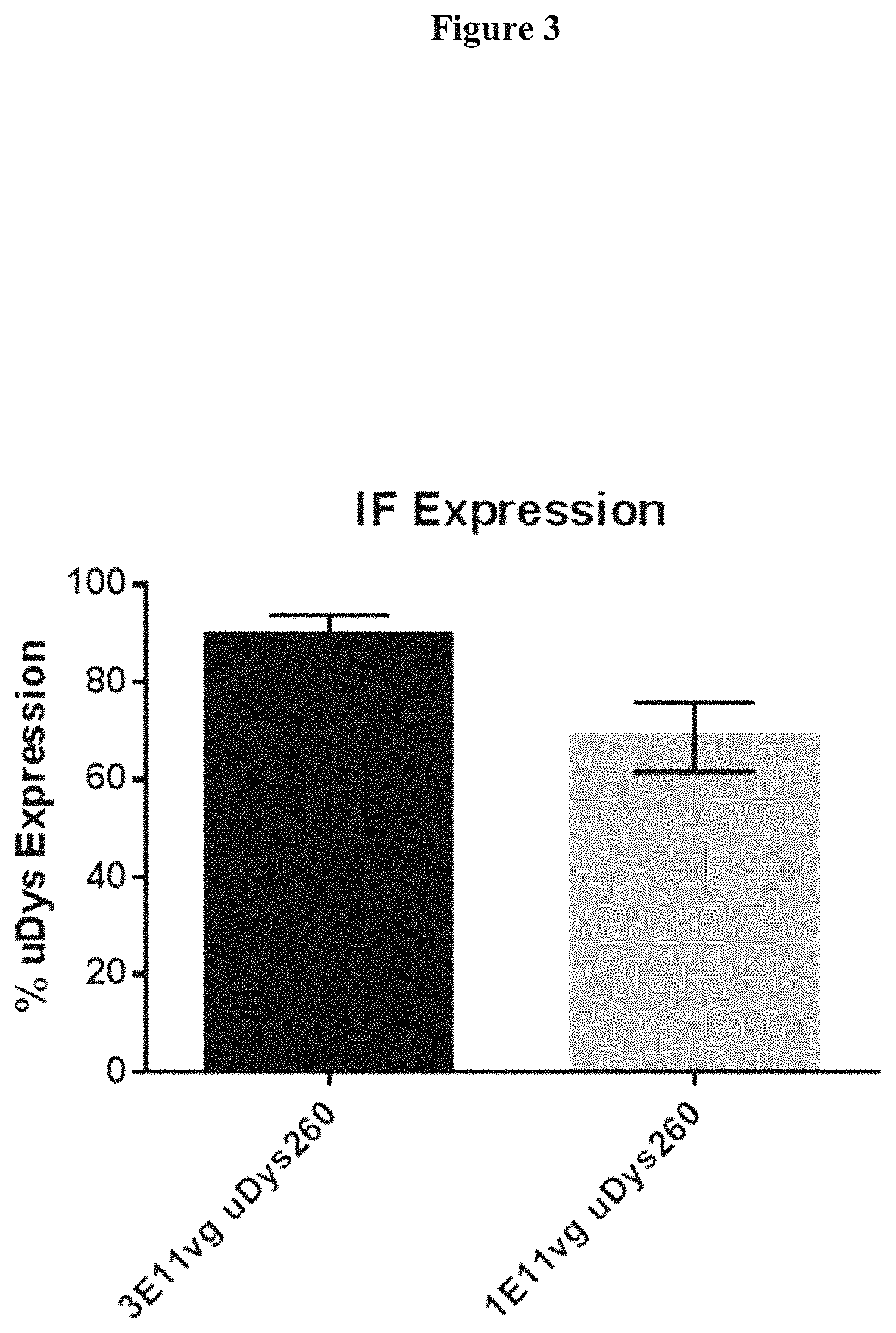Adeno-associated virus vector delivery of a fragment of micro-dystrophin to treat muscular dystrophy
a technology of microdystrophin and adenovirus, which is applied in the direction of viruses/bacteriophages, peptides, genetic material ingredients, etc., can solve the problems of serious impact on quality of life, deficiency of muscle function, and muscular dystrophy, so as to prevent new fibrosis, reduce muscle mass, and reduce muscle force
- Summary
- Abstract
- Description
- Claims
- Application Information
AI Technical Summary
Benefits of technology
Problems solved by technology
Method used
Image
Examples
example 1
Generation of the pAAV.MHCK7.micro-dystrophin.C-terminus Construct
[0087]The pAAV.MHCK7.micro-dystrophin.C-term plasmid contained a human micro-dystrophin cDNA expression cassette flanked by AAV2 inverted terminal repeat sequences (ITR). The micro-dystrophin cassette included the C-terminal domain of dystrophin allowing it to bind to endogenous binding partners (Syntrophins, α-Dystrobrevin, nNOS) important for cell signaling events. Initial work with this cassette was focused on cardiac delivery and utilized an M260 promoter and AAV9. Very good expression and function was achieved in the heart, but very little skeletal muscle expression (Straub & Campbell, Curr Opin Neurol 10, 168-175 (1997).
[0088]This cassette was cloned it into the AAV2.MHCK7 / synthetic polyA backbone to achieve cardiac and skeletal muscle expression (FIG. 1) as described in Sacco et al. Cell 143, 1059-1071 (2010), Wallace et al. Annu Rev Physiol 71, 37-57 (2009) and Zhou et al. J Neuropathol Exp Neurol 69, 771-776 ...
example 2
Intramuscular Expression Studies Using pAAV.MHCK7.micro-dystrophin.C-terminus
[0090]Expression studies were conducted with this human micro-dystrophin containing the C terminus cassette (rAAVrh.74.MHCK7.micro-dys.c-term) by intramuscular injection. The tibialis anterior muscle of mdx mice was injected with 1×1011 vg or 3×1011 vg (n=5 per group). Six weeks later the muscles were harvested and stained for dystrophin expression with the C-terminal polyclonal antibody. The results of the dose study are presented below in FIG. 2. Comparative dosing at 1e11 and 3e11 vg demonstrates that good gene expression was achieved at both the low and high dose. Immunohistological staining for dystrophin with the C-terminal polyclonal antibody indicated dose dependent expression (FIG. 3).
example 3
Systemic Delivery of pAAV.MHCK7.micro-dystrophin.C-terminus to mdx Mice
[0091]Cohorts of mdx mice were injected with 6e12 vg (2e14 vg / kg) of rAAVrh.74.MHCK7.micro-dys.c-term. Systemically injected (tail vein) mdx mice (n=5) showed high levels of staining throughout all muscles. FIG. 4 represents the widespread transduction of cardiac muscle fibers after a 6e12 vg systemic dose. Following 6 weeks of treatment, all muscles were harvested and the number of dystrophin positive fibers were quantified (Table 1).
PUM
| Property | Measurement | Unit |
|---|---|---|
| muscular force | aaaaa | aaaaa |
| muscle mass | aaaaa | aaaaa |
| muscle strength | aaaaa | aaaaa |
Abstract
Description
Claims
Application Information
 Login to View More
Login to View More - R&D
- Intellectual Property
- Life Sciences
- Materials
- Tech Scout
- Unparalleled Data Quality
- Higher Quality Content
- 60% Fewer Hallucinations
Browse by: Latest US Patents, China's latest patents, Technical Efficacy Thesaurus, Application Domain, Technology Topic, Popular Technical Reports.
© 2025 PatSnap. All rights reserved.Legal|Privacy policy|Modern Slavery Act Transparency Statement|Sitemap|About US| Contact US: help@patsnap.com



